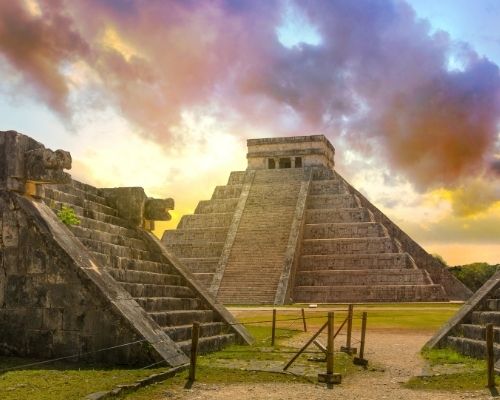Due to its unique characteristics, Chichen Itza is considered a World Heritage Site and one of the New Seven Wonders of the Modern World.
In the same way that Antipater of Sidon, a
Greek poet, listed in one of his poems 7 buildings of the ancient world that
according to his opinion were a synthesis of beauty, and of which unfortunately
today only the pyramid of Giza remains as a testimony of its existence.
The Swiss Brendan Weber, a founder of the New Open World Corporation company, decided to publish a call to choose the New
Seven Wonders of the Modern World that had been created from the beginning of
history until the year 2000 and that as a condition still stood.
 |
| Chichen Itza |
The dynamic was to vote by email, text
message, or by phone and cast a vote for the work that was personally the most
amazing of all. Weber declared to have received 100 million votes, of which a
long list of candidate buildings could be obtained that was reduced to only 21
semifinalists. The final results were announced on July 7, 2007, (07/07/07), in
a majestic ceremony at the Estadio de la Luz in Lisbon, Portugal.
Based on the highest concentration of
votes, the final 7 winners were announced: Christ the Redeemer in Brazil, Machu
Picchu, Cusco in Peru, the Great Wall in China; the city of Petra in Jordan,
the Taj Mahal in India, the Colosseum in Rome in Italy and the sacred city of
Chichen Itza in Mexico. It is worth mentioning that except for Christ the
Redeemer or Christ Corcovado, all other buildings have also been recognized as
World Heritage Sites by the United Nations Educational, Scientific and Cultural
Organization, UNESCO.
After almost a thousand years of
permanence, Chichen Itza is recognized throughout the world
In the case of Chichen Itza, recognition as
a World Heritage Site was granted by UNESCO in 1988. This specialized agency of
the United Nations mentioned that it is one of the most important examples of
the Maya-Toltec civilization that have survived the passage of the time due to
the fusion of construction techniques and that "(...) throughout their
almost a thousand years of history, the Mayans and Toltecs left their vision of
the world and the universe inscribed in their stone monuments and works of
art", among which are mentioned: The Pyramid of Kukulkán, The Temple of
the Warriors and El Caracol.
Chichen Itza, in Mexico, is one of the essential attractions of the Yucatan
peninsula, an archaeological center that is among the most important in the
world and is even part of the Seven
Wonders of the Modern World,
next to the Roman Coliseum, the Great Wall. China and Christ the Redeemer in
Brazil, to give other examples.
The name Chichen Itza comes from the Mayan,
and translates as 'Mouth of the well of the water witches'. It is one of the
most important ancient buildings in the municipality of Tulum and the Mayan civilization in particular. The
constructions of Chichen Itza come from the so-called postclassic period when
the Mayan civilization was already beginning its process of decline.
The main god that reigns over the city is Kukulcán,
the Mayan representation of the legendary Quetzalcóatl, an originally Toltec
figure. The influence of this other civilization in the construction of the
Mayan temple accounts for the passing of the years and the different stages
that the creation of this majestic religious center had.
In 1988 the archaeological zone of Chichen Itza became part of the UNESCO World Heritage Site,
and in July 2007 it was announced that the city was chosen to be part of the
new Seven Wonders of the Modern World.
 |
| Chichen Itza |
The pyramid of Kukulcán
It is the most important building, the
center of Chichen Itza, and around which the city was expanded. It is also
known as 'the castle', and it is one of the most important demonstrations
of Mayan architecture, which is still preserved intact. It is a four-sided pyramid that culminates in a temple with a rectangular
base in the highest part. On each side of the pyramid, there is a staircase
with 91 steps, and one more to go up to the temple. The result of the sum is
365, referring to the days of the year.
One of the most surprising aspects of the
construction of the pyramid is the play of light that occurs during the
equinox. The shadows projected on the platforms simulate the arrival of Kukulcán, the serpent, and his descent to earth. As the hour's pass, the
shadow of the serpent descends from the top of the temple until it ends in the
stone head at the base of the pyramid.
 |
| Chichen Itza |
The Cenote of sacrifices
Another area that we cannot miss in Chichen Itza is the Sacred Cenote, a large open-air cenote, with a diameter of 60
meters, where the ancient Mayans made different offerings and sacrifices for the god Chaac, ruler of the rains...














No comments:
Post a Comment